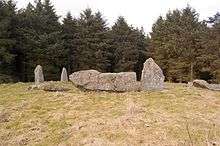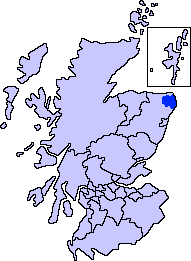Old Deer

Old Deer (Scots: Auld Deer,[1] Scottish Gaelic: Dèir) a parish and village in the district of Buchan, Aberdeenshire, Scotland. The population in 2011 was 152. The village lies on the Deer or South Ugie Water, 10.1 miles west of Peterhead, and two miles from Mintlaw. Industries include distilling, brewing, and the manufacture of woollens, and there are quarries of granite and limestone.
The village is the birthplace of David B. Henderson, one of only two foreign born Speakers of the United States House of Representatives.
The thriving village of New Deer (formerly called Auchreddie) lies about seven miles west of the older village; to the north of New Deer is the ruined Fedderate Castle.
Monastery
Columba and his nephew Drostan founded a monastery here in the 6th century, of which no trace remains. The Book of Deer is a most interesting relic of the monks, which was discovered in 1857 in the Cambridge University library by Henry Bradshaw. It was probably stolen during the Wars of Scottish Independence by English troops. It is a small manuscript of the Gospels in the Vulgate, fragments of the liturgy of the Celtic church, and notes, in the Gaelic script of the 12th century, referring to the charters of the ancient monastery, including a summary of that granted by David I of Scotland. These are among the oldest examples of Scottish Gaelic. The manuscript is also adorned with Gaelic designs. It had belonged to the monks of Deer and been in the possession of the University Library since 1715. It was edited by John Stuart for the Spalding Club, by whom it was published in 1869 under the title The Book of Deer (Leabhar Dhèir in Gaelic).
In 1218 William Comyn, earl of Buchan, founded the Abbey of St Mary of Deer, now in ruins, 3⁄4 mi (1.2 km) farther up the river than the monastery and on the opposite bank. Although it was erected for Cistercians from the priory of Kinloss, near Forres, the property of the Columban monastery was removed to it. The founder (died 1233) and he and his countess were buried in the church. The parish is rich in antiquities, but the most noted of them is the Stone of Deer, a sculptured block of syenite, which stood near the abbey; it was destroyed in 1854.
Aikey Brae stone circle

Aikey Brae's stone circle, excavated by Richard Bradley in 2001, lies within the parish on the edge of Bridgend Wood, between Maud and Old Deer, south of B9029 on the summit of Parkhouse Hill in the north of Aberdeenshire, Scotland. It is a nearly complete recumbent stone circle. Characteristic of a recumbent stone circle is a "recumbent stone" accompanied by two standing, high, often tapering "flank stones", which are within the circle or near the circle. It was constructed in about 2000BC.
The circle consists of ten stones and has a diameter of 14.4 m. The recumbent stone weighs 21.5 tons and, like its high flank stones (one of which has fallen down) is made of basalt, which does not occur nearby. The rest of the stones are made of local granite, sorted by size, with the largest one next to the flanks and the smallest ones lying opposite.
It is a scheduled ancient monument. [2]
See also
References
- ↑ Scots Language Centre: Scottish Place Names in Scots
- ↑ "Parkhouse Hill stone circle (Aikey Brae)SM2". Historic Environment Scotland. Retrieved 7 September 2017.

- Abbey of Deer - Article in the Catholic Encyclopedia
- This article contains material translated from the article de:Aikey Brae on German Wikipedia.
| Wikimedia Commons has media related to Old Deer. |

